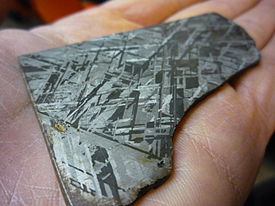- NiFe
-
NiFe or Nife is a general shorthand expression for a mixture of nickel (Ni) and iron (Fe). NiFe is used to describe nickel-iron batteries, various chemical reactions that involve a nickel-iron catalyst or component, and in geology to describe the general composition of the Earth's core.
The affinity of nickel (atomic number 28) and iron (atomic number 26) for one another produce natural occurring alloys, a large number of commercial alloys, and provide a complex electron environment for catalyzing chemical reactions.[1]
Iron and nickel are notable for being the final elements produced by stellar nucleosynthesis, and thus the heaviest elements which do not require a supernova or similarly cataclysmic event for formation.[2] Iron and nickel are therefore the most abundant metals in metallic meteorites[3] and in the dense-metal cores of planets such as Earth.
Notes
- ^ Pardo, Alejandro et al. (April 2006) "Density functional study of the catalytic cycle of nickel–iron [NiFe] hydrogenases and the involvement of high-spin nickel(II)" Journal of Biological Inorganic Chemistry 11(3): pp. 286-306;
- ^ Wannier, P. G. et al. (September 1980) "Nuclear Abundances and Evolution of the Interstellar Medium"Annual Review of Astronomy and Astrophysics 18(1): pp. 399-437, (doi: 10.1146/annurev.aa.18.090180.002151);
- ^ Mason, Brian Harold (1971) Handbook of Elemental Abundances in Meteorites Gordon and Breach, New York, ISBN 0-677-14950-6 ;
See also
- Invar, nickel-iron alloy
- Mu-metal, nickel-iron alloy
- KREEP, geochemical term for lunar impact melt breccias and basalts
- Sial, geochemical term for outer planetary crustal layer
- Sima (geology), geochemical term for inner planetary crustal layer
- Structure of the Earth's Core, NiFe as primary constituent

This article related to petrology is a stub. You can help Wikipedia by expanding it.

